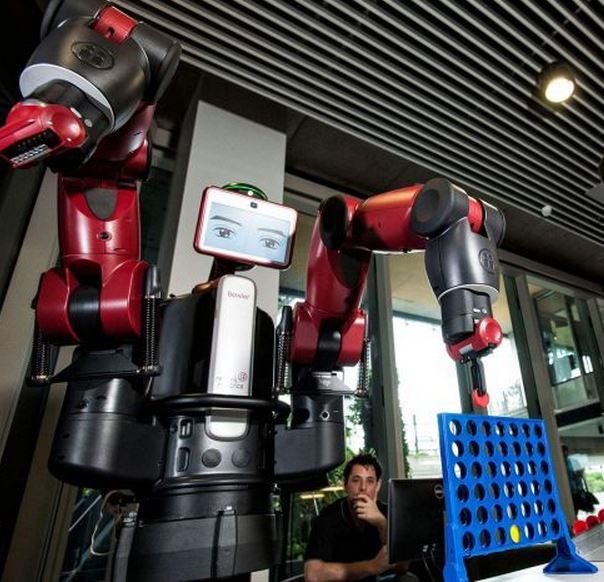Robots cannot work next to humans safely because they are not yet equipped to recognize and avoid obstacles in their way, but this is about to change, says a team of scientists from Queensland University of Technology (QUT) in Brisbane, Australia, as they introduce ‘Baxter’, a roboticist’s best friend.
Baxter, QUT’s latest robot, is helping scientists break down the technological boundaries that prevent them from working safely alongside humans.
The secret, they say, is getting them to see and perceive the world around them as we do.

Baxter the robot playing Four Connect. It is being taught to see the world as we do. (Image: QUT)
Professor Peter Corke, world-famous roboticist with QUT’s Science and Engineering Faculty and Director of the Australian Centre for Robotic Vision (ACRV), said:
“Once robots can see and understand the environment they operate in they can make decisions that allow them to work safely beside us.”
“Current industrial robots are dangerous for humans to work around because they’re simply not equipped to recognize and avoid obstacles suddenly in their way.”
“Baxter uses a range of sensors to detect movement around it, as well as spring-loaded joints which stop it continuing a pre-programmed movement if it meets an unexpected obstacle. We’ve tried to ‘rush’ Baxter before and can certainly vouch for his quick reflexes.”
Video – Baxter the robot
ACRV scientists have already programmed Baxter to use cyber-vision to play the unbeatable game of Connect Four (a game where the player has to line up four consecutive pegs of the same colour either vertically, horizontally, or diagonally).
Baxter is now being taught to recognize and pick up ripe capsicums (peppers).
Robots that ‘see’ real-world environments
ACRV researchers say they are creating the next generation of robots that will be able to see and understand complex, real-world environments.
They are currently carrying out studies on the use of robotic vision to create sophisticated farming tools, develop low-cost solutions for some medical and health problems, and combat Crown of Thorn starfish outbreaks on the Great Barrier Reef.
ACRV Chief Operating Officer, Dr Sue Keay, said:
“Robotic vision is the key enabling technology that will allow robotics to transform labour-intensive industries, disrupt stagnant markets and see robots become a ubiquitous feature of the modern world. We consider that ‘seeing’ is far more than just processing images.”
“It’s a complex process tightly coupled to both memory and action, which gives robots the understanding they need to robustly perform tasks that involve objects and places while at the same time providing rapid and continuous feedback for control.”
“Robotic automation has transformed manufacturing, household cleaning and soon cars but robotics has made relatively little headway in other industries where the world is complex and time varying, like retail. Robots that can see, learn and respond as humans do will increase productivity in industries critical to Australia’s economy.”
Brisbane citizens will have the opportunity to see Baxter face-to-face and other ACRV robots at “Robotronica”, QUT’s robotics extravaganza, in August 2015.
ACRV Video – Robotic Vision
